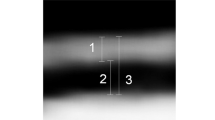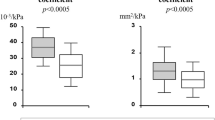Abstract
Preclinical vascular changes (increased stiffness and/or wall thickness) have been observed in children with known metabolic risk factors. Aim of the present study was to evaluate different carotid parameters, representative of vascular health, in children with and without metabolic syndrome (MS). We studied 38 children with MS (mean age 9.6±2.6 years; range 6–14 years) and 45 healthy age-matched subjects. Children who met three or more of the following criteria qualified as having the MS: fasting glucose >110 mg dl−1, fasting triglyceride concentration >100 mg dl−1, fasting high-density lipoprotein cholesterol concentration <50 mg dl−1 for females or <45 mg dl−1 for the males, waist circumference >75th percentile for age and gender and systolic or diastolic blood pressure >90th percentile for age, gender and height. Carotid B-mode ultrasound examinations were performed and intima–media thickness and diameters were measured in all subjects. Arterial geometry was further characterized by calculation of carotid cross-sectional area. Carotid intima–media thickness and lumen diameters were increased in children with MS as compared to children without MS. Moreover, carotid cross-sectional area was significantly higher in the group of children with MS 9.83±1.86 mm2 [mean±s.d.] compared with the control group: 7.77±1.72 mm2, P<0.001, even after adjustment for age, gender and height. Carotid hypertrophy is already detectable in children with MS. High-resolution B-mode ultrasound could provide a valuable tool for the cardiovascular risk stratification of children.
This is a preview of subscription content, access via your institution
Access options
Subscribe to this journal
Receive 12 digital issues and online access to articles
$119.00 per year
only $9.92 per issue
Buy this article
- Purchase on Springer Link
- Instant access to full article PDF
Prices may be subject to local taxes which are calculated during checkout

Similar content being viewed by others
References
Newman III WP, Wattigney W, Berenson GS . Autopsy studies in United States children—adolescents and adolescents. Relationship of risk factors to atherosclerotic lesions. Ann NY Acad Sci 1991; 623: 16–25.
Strong JP . Natural history and risk factors for early human atherogenesis: pathobiological determinants of atherosclerosis in youth (PDAY) research group. Clin Chem 1995; 41: 134–138.
Stary HC, Blankenhorn DH, Chandler AB, Glagov S, Insull Jr W, Richardson M et al. A definition of the intima of human arteries and of its atherosclerosis-prone regions. A report from the Committee on Vascular Lesions of the Council on Arteriosclerosis, American Heart Association. Circulation 1992; 85: 391–405.
Celermajer DS, Sorensen KE, Gooch VM, Spiegelhalter DJ, Miller OI, Sullivan ID et al. Non-invasive detection of endothelial dysfunction in children and adults at risk of atherosclerosis. Lancet 1992; 340: 1111–1115.
Gaeta G, De Michele M, Cuomo S, Guarini P, Foglia MC, Bond MG et al. Arterial abnormalities in the offspring of patients with premature myocardial infarction. N Engl J Med 2000; 343: 840–846.
Iannuzzi A, Licenziati MR, Acampora C, Salvatore V, De Marco D, Mayer MC et al. Preclinical changes in the mechanical properties of abdominal aorta in obese children. Metabolism 2004; 53: 1243–1246.
Sass C, Herbeth B, Chapet O, Siest G, Visvikis S, Zannad F . Intima–media thickness and diameter of carotid and femoral arteries in children, adolescents and adults from the Stanislas cohort: effect of age, sex, anthropometry and blood pressure. J Hypertens 1998; 16: 1593–1602.
Pauciullo P, Iannuzzi A, Sartorio R, Irace C, Covetti G, Di Costanzo A et al. Increased intima–media thickness of the common carotid artery in hypercholesterolemic children. Arterioscler Thromb 1994; 14: 1075–1079.
Tonstad S, Joakimsen O, Stensland-Bugge E, Leren TP, Ose L, Russell D et al. Risk factors related to carotid intima–media thickness and plaque in children with familial hypercholesterolemia and control subjects. Arterioscler Thromb Vasc Biol 1996; 16: 984–991.
Jarvisalo MJ, Putto-Laurila A, Jartii L, Lehtimaki T, Solakivi T, Ronnemaa T et al. Carotid artery intima–media thickness in children with type 1 diabetes. Diabetes 2002; 51: 493–498.
Iannuzzi A, Licenziati MR, Acampora C, Salvatore V, Auriemma L, Romano ML et al. Increased carotid intima–media thickness and stiffness in obese children. Diabetes Care 2004; 27: 2506–2508.
Roman MJ, Pickering TG, Schwartz JE, Pini R, Devereux RB . Relation of blood pressure variability to carotid atherosclerosis and carotid artery and left ventricular hypertrophy. Arterioscler Thromb Vasc Biol 2001; 21: 1507–1511.
Nowak J, Nilsson T, Sylven C, Jogestrand T . Potential of carotid ultrasonography in the diagnosis of coronary artery disease: a comparison with exercise test and variance ECG. Stroke 1998; 29: 439–446.
Genovesi S, Giussani M, Pieruzzi F, Vigorita F, Arcovio C, Cavuto S et al. Results of blood pressure screening in a population of school-aged children in the province of Milan: role of overweight. J Hypertens 2005; 23: 493–497.
Invitti C, Gilardini L, Pontiggia B, Mazzilli G, Sartorio A, Morabito F . Prevalence and concomitance of high blood pressure in Italian obese children. J Hypertens 2005; 23: 1605–1606.
Weiss R, Dziura J, Burgert TS, Tamborlane WV, Taksali SE, Yeckel CW et al. Obesity and the metabolic syndrome in children and adolescents. N Engl J Med 2004; 350: 2362–2374.
de Ferranti SD, Gauvreau K, Ludwig DS, Neufeld EJ, Newburger JW, Rifai N . Prevalence of the metabolic syndrome in American adolescents: findings from the Third National Health and Nutrition Examination Survey. Circulation 2004; 110: 2494–2497.
Duncan GE, Li SM, Zhou XH . Prevalence and trends of a metabolic syndrome phenotype among U.S. adolescents, 1999–2000. Diabetes Care 2004; 27: 2438–2443.
Update on the 1987 task force report on high blood pressure in children and adolescents: a working group report from the national high blood pressure education program. Pediatrics 1996; 98: 649–658.
Glagov S, Weisenberg E, Zarins CK, Stankunavicius R, Kolettis GJ . Compensatory enlargement of human atherosclerotic coronary arteries. N Engl J Med 1987; 316: 1371–1375.
Pasterkamp G, Wensing PJ, Post MJ, Hillen B, Mali WP, Borst C . Paradoxical arterial wall shrinkage may contribute to luminal narrowing of human atherosclerotic femoral arteries. Circulation 1995; 91: 1444–1449.
Pasterkamp G, Borst C, Post MJ, Mali WP, Wensing PJ, Gussenhoven EJ et al. Atherosclerotic arterial remodeling in the superficial femoral artery. Individual variation in local compensatory enlargement response. Circulation 1996; 93: 1818–1825.
Crouse JR, Goldbourt U, Evans G, Pinsky J, Sharrett AR, Sorlie P, et al., ARIC Investigators. Risk factors and segment-specific carotid arterial enlargement in the Atherosclerosis Risk in Communities (ARIC) cohort. Stroke 1996; 27: 69–75.
Bonithon-Kopp C, Touboul PJ, Berr C, Magne C, Ducimetiere P . Factors of carotid arterial enlargement in a population aged 59–71 years. The EVA study. Stroke 1996; 27: 654–660.
Jensen-Urstad K, Jensen-Urstad M, Johansson J . Carotid artery diameter correlates with risk factors for cardiovascular disease in a population of 55-year-old subjects. Stroke 1999; 30: 1572–1576.
Bonora E, Kiechl S, Willeit JS, Oberhollenzer F, Egger G, Bonadonna RC et al. Carotid atherosclerosis and coronary artery disease in the metabolic syndrome: prospective data from the Bruneck study. Diabetes Care 2003; 26: 1251–1257.
Scuteri A, Najjar SS, Muller DC, Andres R, Hougaku H, Metter EJ et al. Metabolic syndrome amplifies the age-associated increases in vascular thickness and stiffness. J Am Coll Cardiol 2004; 43: 1388–1395.
Tzou WS, Douglas PS, Srinivasan SR, Bond MG, Tang R, Chen W et al. Increased subclinical atherosclerosis in young adults with metabolic syndrome: the Bogalusa Heart Study. J Am Coll Cardiol 2005; 46: 457–463.
Iannuzzi A, De Michele M, Bond MG, Sacchetti L, Fortunato G, Salvatore F et al. Carotid artery remodeling in middle-aged women with the metabolic syndrome (from the ‘Progetto Atena’ study). Am J Cardiol 2005; 96: 1162–1165.
Iannuzzi A, Licenziati MR, Acampora C, Renis M, Agrusta M, Romano L et al. Carotid artery stiffness in obese children with the metabolic syndrome. Am J Cardiol 2006; 97: 528–531.
Ingelfinger JR . Pediatric antecedents of adult cardiovascular disease—Awareness and intervention. N Engl J Med 2004; 350: 2123–2126.
de Ferranti SD, Gauvreau K, Ludwig DS, Newburger JW, Rifai N . Inflammation and changes in metabolic syndrome abnormalities in US adolescents: findings from the 1988–1994 and 1999–2000 National Health and Nutrition Examination Surveys. Clin Chem 2006; 52: 1325–1330.
Crouse JR, Craven TE, Hagaman AP, Bond MG . Association of coronary disease with segment-specific intimal–medial thickening of the extracranial carotid artery. Circulation 1995; 92: 1141–1147.
Bots ML, Hoes AW, Koudstaal PJ, Hofman A, Grobbee DE . Common carotid intima–media thickness and risk of stroke and myocardial infarction: the Rotterdam Study. Circulation 1997; 96: 1432–1437.
Woo KS, Chook P, Yu CW, Sung RY, Qiao M, Leung SS . et al. Effects of diet and exercise on obesity-related vascular dysfunction in children. Circulation 2004; 109: 1981–1986.
Acknowledgements
We thank all the parents and their children who participated in this study.
Author information
Authors and Affiliations
Corresponding author
Rights and permissions
About this article
Cite this article
Iannuzzi, A., Licenziati, M., Acampora, C. et al. Carotid artery wall hypertrophy in children with metabolic syndrome. J Hum Hypertens 22, 83–88 (2008). https://doi.org/10.1038/sj.jhh.1002289
Received:
Revised:
Accepted:
Published:
Issue Date:
DOI: https://doi.org/10.1038/sj.jhh.1002289
Keywords
This article is cited by
-
Vascular diameter and intima-media thickness to diameter ratio values of the carotid artery in 642 healthy children
European Journal of Pediatrics (2021)
-
Association of dietary pattern with carotid intima media thickness among children with overweight or obesity
Diabetology & Metabolic Syndrome (2019)
-
Impact of Childhood Obesity on Cardiac Structure and Function
Current Treatment Options in Cardiovascular Medicine (2014)
-
Increased intima-media thickness of the carotid artery in childhood: a systematic review of observational studies
European Journal of Pediatrics (2011)
-
Metabolic syndrome and biventricular hypertrophy in essential hypertension
Journal of Human Hypertension (2009)



